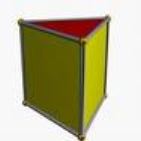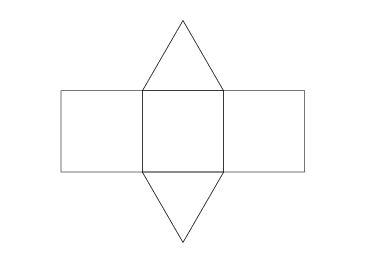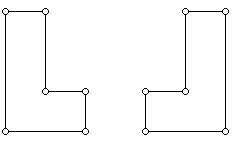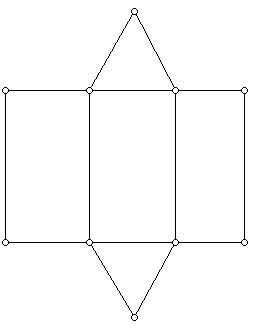
Figure 1
Exploration 1 (Nets of a triangular prism)
prepared by:
Joseph Malkevitch
Department of Mathematics
York College (CUNY)
Jamaica, New York 11451
email:
malkevitch@york.cuny.edu
web page:
http://york.cuny.edu/~malk/
1. Draw at least 5 inequivalent nets for the convex 3-dimensional solid (polyhedron) known as the triangular prism. (This is a solid which consists of three squares and two equilateral triangles.)
Here is a sketch of this solid in the plane:

Here is a sample of one such net:

The crux of the issue here is what is meant by inequivalent. Consider the two shapes below:

It is not possible to rotate and/or translate the shape on the left onto the shape on the right. If this were possible we would say the two shapes are related by a rigid motion. However, there is a distance-preserving transformation of one of the shapes onto the other, an isometry. This transformation is a reflection. If two shapes are related by an isometry (distance preserving transformation), they are called congruent. For nets it is customary to call two nets "different" if they are not congruent.
2. Can you find a complete list of inequivalent nets for the triangular prism?
3. Now consider a solid which is metrically different from the triangular prism with 3 squares and 2 equilateral triangles but is combinatorially equivalent to it. This is the solid which consists of two equilateral triangles and three 1x2 rectangles. The net that corresponds to the one in Figure 2 for this solid is shown in Figure 4.

a. Draw at least 5 nets for this solid.
b. Does this solid have more nets or fewer nets than the triangular prism with squares and equilateral triangles?
c. Can you find a complete list of inequivalent nets for this particular triangular prism?
4. Suppose one has a 3-dimensional solid which is again combinatorially equivalent to the triangular prism but metrically consists of two isosceles triangles with sides of length 2 and a third side of length 1, and whose three quadrilateral faces are a square and two rectangles.
a. What are the dimensions of the three quadrilateral faces?
b. Draw at least 5 nets of this solid.
c. How does the number of nets of this solid compare with that of the two previous solids?
d. Can you find a complete list of inequivalent nets for this particular triangular prism?